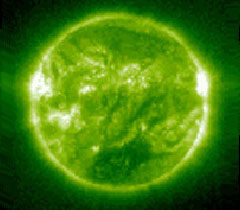Looking for Water
September 1st, 2000 - September 1st, 2001
Categories: VR Art

About
In this networked virtual environment, the user perspective begins in outer space, surrounded by sun and Earth images based on real-time satellite information, than falls to Earth and lands on a northern Lake Michigan archipelago of islands. While exploring these islands, from Death’s Door to the Garden Peninsula, the participants share a watery experience.
The satellite images are an animation of actual Earth and sun weather data collected over months using the web. The images are refreshed daily to form a 3D visual history. The 3D models of the archipelago of islands are based on video images taken while kayaking. The 3D information has been extracted from the moving video images to allow participants to move about and explore these worlds. In the end, the world dissolves into moving water.
Daniel J. Sandin is director of the Electronic Visualization Laboratory (EVL) and a professor in the School of Art and Design at the University of Illinois at Chicago (UIC). His early interest in real-time computer graphics / video image processing and interactive computing environments motivated his pioneering work in video synthesizers and continues to influence his research interests.
Sandin’s research interests include: virtual environments, digital libraries, scientific visualization, new methodologies for informal science and engineering education, paradigms for information display, televisualization (distributed graphics over networks), algorithm optimization for massively parallel computing, sonification, human / computer interfaces, and abstract mathematical visualization. He is receiving recognition, along with EVL co-director Tom DeFanti, for conceiving the CAVE virtual reality theater in 1991.
Sandin’s computer / video art has been exhibited at conferences and museums worldwide, and he has received many awards. Sandin has received grants and fellowships from such distinguished organizations as the Rockefeller Foundation, the Guggenheim Foundation, and the National Endowment for the Arts; and, his work is included in the inaugural collection of video art at the Museum of Modern Art in New York.
Recent virtual reality works include Poverty Island and Gallery of Motions.